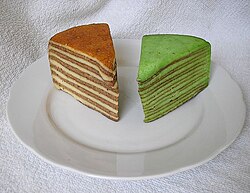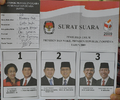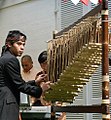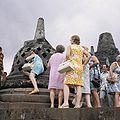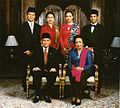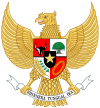Portal:Indonesia
Selamat Datang / Welcome to the Indonesian Portal


Indonesia, officially the Republic of Indonesia, is a country in Southeast Asia and Oceania, between the Indian and Pacific oceans. Comprising over 17,000 islands, including Sumatra, Java, Sulawesi, and parts of Borneo and New Guinea, Indonesia is the world's largest archipelagic state and the 14th-largest country by area, at 1,904,569 square kilometres (735,358 square miles). With over 280 million people, Indonesia is the world's fourth-most-populous country and the most populous Muslim-majority country. Java, the world's most populous island, is home to more than half of the country's population.
Indonesia operates as a presidential republic with an elected legislature and consists of 38 provinces, nine of which have special autonomous status. Jakarta, the largest city, is the world's second-most-populous urban area. Indonesia shares land borders with Papua New Guinea, Timor-Leste, and the eastern part of Malaysia, as well as maritime borders with Singapore, Peninsular Malaysia, Vietnam, Thailand, the Philippines, Australia, Palau, and India. Despite its large population and densely populated regions, Indonesia has vast areas of wilderness that support one of the world's highest levels of biodiversity.
Indonesian society comprises hundreds of ethnic and linguistic groups, with Javanese being the largest. The nation's identity is unified under the motto Bhinneka Tunggal Ika, defined by a national language, cultural and religious pluralism, a history of colonialism and rebellion against it. A newly industrialised country, Indonesia's economy ranks as the world's 16th-largest by nominal GDP and the 8th-largest by PPP. As the world's third-largest democracy and a middle power in global affairs, the country is a member of several multilateral organisations, including the United Nations, World Trade Organization, G20, BRICS and a founding member of the Non-Aligned Movement, Association of Southeast Asian Nations, East Asia Summit, APEC and the Organisation of Islamic Cooperation. (Full article...)
Selected article -
The Indonesian Democratic Party of Struggle (Indonesian: Partai Demokrasi Indonesia Perjuangan, PDI-P) is a centre to centre-left secular-nationalist political party in Indonesia. Since 2014, it has been the ruling and largest party in the House of Representatives (DPR), having won 110 seats in the latest election. The party is led by Megawati Sukarnoputri, who served as the president of Indonesia from 2001 to 2004.
In 1996, Megawati was forced out of the leadership of the Indonesian Democratic Party (PDI) by the New Order government under Suharto. After Suharto's resignation and the lifting of restrictions on political parties, she founded the party. PDI-P won the 1999 legislative election, and Megawati assumed the presidency in July 2001, replacing Abdurrahman Wahid. Following the end of her term, PDI-P became the opposition during the Susilo Bambang Yudhoyono (SBY) administration. Megawati ran with Prabowo Subianto in 2009, but they were defeated by SBY. In 2014, PDI-P nominated Joko Widodo (Jokowi) as its presidential candidate. The party returned to power following its victory in the legislative election, and Jokowi was elected president. PDI-P continued its success in 2019, and Jokowi was re-elected for his second term. In 2024, the party won the legislative election, but its presidential candidate, Ganjar Pranowo, lost to Prabowo. President Jokowi's alleged support for Prabowo strained his relationship with PDI-P, leading to his formal ousting after the Constitutional Court (MK) rejected all claims. (Full article...)
Selected picture

Photographer: Sakurai Midori; License: Creative Commons CC-BY-SA
Selected foods and cuisines -
Spekkoek (Dutch: [ˈspɛkuk] ⓘ; Indonesian: kue lapis legit or spekuk) is a type of Indonesian layer cake. It was developed during colonial times in the Dutch East Indies. The firm-textured cake is an Indo (Dutch-Indonesian) version of the multi-layered rice cakes that are usually seen in Southeast Asian desserts but using some Dutch ingredients like flour and butter. It contains a mix of Indonesian spices, such as cardamom, cinnamon, clove, mace and anise. The cake is made of flour and yolk and is rich in butter or margarine. (Full article...)
Related portals
Religions in Indonesia
Southeast Asia
Other countries
Selected biography -
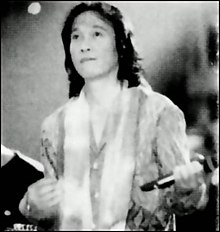
Hajji Chrismansyah Rahadi ([xrisˈmanʃah raˈhadi]; born Christian Rahadi [xristiˈan raˈhadi]; 16 September 1949 – 30 March 2007), better known by his stage name Chrisye ([xəˈriʃə]), was an Indonesian progressive pop singer and songwriter. In 2011, Rolling Stone Indonesia declared him the third-greatest Indonesian musician of all time.
Born in Jakarta of mixed Chinese-Indonesian descent, Chrisye became interested in music at an early age. At high school he played bass guitar in a band he formed with his brother, Joris. In the late 1960s he joined Sabda Nada (later Gipsy), a band led by his neighbours, the Nasutions. In 1973, after a short hiatus, he rejoined the band to play in New York for a year. He briefly returned to Indonesia and then went back to New York with another band, the Pro's. After once again returning to Indonesia, he collaborated with Gipsy and Guruh Sukarnoputra to record the 1976 indie album Guruh Gipsy. (Full article...)
Did you know -
- ... that in the 12th century, Bintan Island (pictured) in the Strait of Malacca was known as the "Pirate Island" since the Malay pirates used to loot trading ships sailing in these waters?
- ... that Javanese people have no family name, and many have only one?
- ... that the Sumatran striped rabbit is only found in forest in the Barisan Mountains in Western Sumatra, and specimens are often found decades apart?
More Did you know (auto generated)

- ... that after completing his tenure as regent, Tatto Suwarto Pamuji walked 96 kilometres (60 mi) to fulfill a vow he made?
- ... that after his tenure ended in 1964, Ipik Gandamana would be the last Indonesian minister of home affairs to be a civilian until 2009?
- ... that although more than a thousand used Japanese train cars had previously been imported into Indonesia, the Indonesian government blocked a recent attempt to import more?
- ... that during the 1970s, future Indonesian president Habibie would go to a specific noodle shop every lunchtime?
- ... that two of three candidates in the 2018 mayoral race in Malang, Indonesia, were arrested for bribery before the election?
- ... that the building housing the city council of Palembang, Indonesia, was claimed to be the "grandest" of its kind?
In this month
- 8 February 2002 – Ada Apa dengan Cinta?, credited with reinvigorating the Indonesian film industry, is released
- 13 February 2002 – The Malino II Accord, an attempt to stop the Maluku sectarian conflict, is signed
- 15 February 1950 – The People's Representative Council holds its first meeting
- 17 February 1745 – Pakubuwana II establishes the Surakarta Sunanate in Surakarta
- 22 February 1978 – Istiqlal Mosque (pictured) in Jakarta, the largest mosque in Southeast Asia, is inaugurated
General images
Topics
Categories
New articles
Rules | Match log | Results page (for watching) | Last updated: 2025-02-15 20:52 (UTC)
Note: The list display can now be customized by each user. See List display personalization for details.
- Samarinda Kota (edit | talk | history | links | watch | logs | tools) by DDG9912 (talk · contribs · new pages (4)) started on 2025-02-15, score: 103
- Governor of Bali (edit | talk | history | links | watch | logs | tools) by Wong cilik iso gemuyu (talk · contribs · new pages (2)) started on 2025-02-15, score: 136
- Kartika Wijaya (edit | talk | history | links | watch | logs | tools) by Jpatokal (talk · contribs · new pages (4)) started on 2025-02-14, score: 79
- 2029 Bali gubernatorial election (edit | talk | history | links | watch | logs | tools) by Everywiki (talk · contribs · new pages (14)) started on 2025-02-14, score: 63
- Fofi (edit | talk | history | links | watch | logs | tools) by SoupOnChill (talk · contribs · new pages (14)) started on 2025-02-14, score: 42
- 2029 Indonesian presidential election (edit | talk | history | links | watch | logs | tools) by Everywiki (talk · contribs · new pages (14)) started on 2025-02-14, score: 71
- Wassiamull Assomull (edit | talk | history | links | watch | logs | tools) by MaplesyrupSushi (talk · contribs · new pages (9)) started on 2025-02-14, score: 28
- Meshaal Hamzah (edit | talk | history | links | watch | logs | tools) by Das osmnezz (talk · contribs · new pages (15)) started on 2025-02-14, score: 61
- Music of Hadhramaut (edit | talk | history | links | watch | logs | tools) by Wikiyem (talk · contribs · new pages (7)) started on 2025-02-14, score: 26
- SFC120-V Series (edit | talk | history | links | watch | logs | tools) by Irfan Muhammad Rinoarashi (talk · contribs · new pages (1)) started on 2025-02-13, score: 50
- Lepki people (edit | talk | history | links | watch | logs | tools) by Faldi00 (talk · contribs · new pages (10)) started on 2025-02-13, score: 62
- Wayan Arta (edit | talk | history | links | watch | logs | tools) by Damskyyy (talk · contribs · new pages (4)) started on 2025-02-13, score: 32
- Alfharezzi Buffon (edit | talk | history | links | watch | logs | tools) by Damskyyy (talk · contribs · new pages (4)) started on 2025-02-13, score: 72
- Jehan Pahlevi (edit | talk | history | links | watch | logs | tools) by Damskyyy (talk · contribs · new pages (4)) started on 2025-02-13, score: 63
- Redrose Records (edit | talk | history | links | watch | logs | tools) by Ditaap13 (talk · contribs · new pages (2)) started on 2025-02-13, score: 63
- Alfiansyah (footballer) (edit | talk | history | links | watch | logs | tools) by Hericha15 (talk · contribs · new pages (3)) started on 2025-02-01, score: 53
- Stop the Boats — The Lie of Saving Lives at Sea (edit | talk | history | links | watch | logs | tools) by Bonadea (talk · contribs · new pages (27)) started on 2025-02-12, score: 26
- Banten-Dutch war (1656-1659) (edit | talk | history | links | watch | logs | tools) by Sandro908 (talk · contribs · new pages (5)) started on 2025-02-10, score: 106
- Ngalum people (edit | talk | history | links | watch | logs | tools) by Faldi00 (talk · contribs · new pages (10)) started on 2025-02-10, score: 52
- Lost In Harmony (edit | talk | history | links | watch | logs | tools) by Ditaap13 (talk · contribs · new pages (2)) started on 2025-02-10, score: 42
- 2003 Yalengga raid (edit | talk | history | links | watch | logs | tools) by Sandro908 (talk · contribs · new pages (5)) started on 2025-02-09, score: 42
- Rayssa Dynta (edit | talk | history | links | watch | logs | tools) by Semampunya (talk · contribs · new pages (10)) started on 2025-02-09, score: 63
- List of writing systems of Indonesia (edit | talk | history | links | watch | logs | tools) by Bamboofirdaus (talk · contribs · new pages (1)) started on 2025-02-09, score: 248
- Cocoa bean fermentation (edit | talk | history | links | watch | logs | tools) by Rollinginhisgrave (talk · contribs · new pages (6)) started on 2025-02-09, score: 27
- Losari (edit | talk | history | links | watch | logs | tools) by Phantasmcoa (talk · contribs · new pages (5)) started on 2025-02-09, score: 42
- Simbang (edit | talk | history | links | watch | logs | tools) by Phantasmcoa (talk · contribs · new pages (5)) started on 2025-02-08, score: 42
- Banten Invasion of Pajajaran (edit | talk | history | links | watch | logs | tools) by Sandro908 (talk · contribs · new pages (5)) started on 2025-01-28, score: 83
- 2024–25 Liga 4 Maluku (edit | talk | history | links | watch | logs | tools) by Fau Tzy (talk · contribs · new pages (7)) started on 2025-02-08, score: 73
- Derry Sudarisman (edit | talk | history | links | watch | logs | tools) by SchwartzMorgan (talk · contribs · new pages (3)) started on 2025-02-08, score: 22
- Cikoko (Transjakarta) (edit | talk | history | links | watch | logs | tools) by RangersRus (talk · contribs · new pages (19)) started on 2025-02-08, score: 62
- Simbang, Maros (edit | talk | history | links | watch | logs | tools) by SoupOnChill (talk · contribs · new pages (14)) started on 2025-02-08, score: 62
- Ricefield Town F.C. (edit | talk | history | links | watch | logs | tools) by InsidePitch 48 (talk · contribs · new pages (3)) started on 2025-02-08, score: 63
- Sunook (edit | talk | history | links | watch | logs | tools) by SoupOnChill (talk · contribs · new pages (14)) started on 2025-02-08, score: 42
- Kawin Ganteng (edit | talk | history | links | watch | logs | tools) by SchwartzMorgan (talk · contribs · new pages (3)) started on 2025-02-08, score: 22
- Samarinda Ulu (edit | talk | history | links | watch | logs | tools) by DDG9912 (talk · contribs · new pages (4)) started on 2025-02-08, score: 72
- Klaso (edit | talk | history | links | watch | logs | tools) by SoupOnChill (talk · contribs · new pages (14)) started on 2025-02-08, score: 42
- Gatot Subroto Airport (edit | talk | history | links | watch | logs | tools) by Arif Faturahman (talk · contribs · new pages (2)) started on 2025-02-08, score: 92
- 2024–25 Liga 4 West Sumatra (edit | talk | history | links | watch | logs | tools) by Fau Tzy (talk · contribs · new pages (7)) started on 2025-02-08, score: 63
- 2025 IBL Indonesia (edit | talk | history | links | watch | logs | tools) by Greenman (talk · contribs · new pages (11)) started on 2025-02-07, score: 138
- Bagun (edit | talk | history | links | watch | logs | tools) by SoupOnChill (talk · contribs · new pages (14)) started on 2025-02-07, score: 42
- Oetit Koswara (edit | talk | history | links | watch | logs | tools) by Jeromi Mikhael (talk · contribs · new pages (5)) started on 2025-02-07, score: 63
- Tinada (edit | talk | history | links | watch | logs | tools) by SoupOnChill (talk · contribs · new pages (14)) started on 2025-02-07, score: 42
- Yuhara Sukra (edit | talk | history | links | watch | logs | tools) by Jeromi Mikhael (talk · contribs · new pages (5)) started on 2025-02-05, score: 46
- Home Sweet Loan (edit | talk | history | links | watch | logs | tools) by Semampunya (talk · contribs · new pages (10)) started on 2025-02-06, score: 43
- 2024–25 Liga 4 Central Sulawesi (edit | talk | history | links | watch | logs | tools) by Fau Tzy (talk · contribs · new pages (7)) started on 2025-02-06, score: 78
- 2024–25 Liga 4 West Sulawesi (edit | talk | history | links | watch | logs | tools) by Fau Tzy (talk · contribs · new pages (7)) started on 2025-02-06, score: 73
- Sayung (edit | talk | history | links | watch | logs | tools) by SoupOnChill (talk · contribs · new pages (14)) started on 2025-02-06, score: 62
- Rahmat Mirzani Djausal (edit | talk | history | links | watch | logs | tools) by Juxlos (talk · contribs · new pages (10)) started on 2025-02-05, score: 73
- Indonesia at the 2024 World Aquatics Championships (edit | talk | history | links | watch | logs | tools) by WildCherry06 (talk · contribs · new pages (124)) started on 2025-02-05, score: 43
- 2024–25 Liga 4 Bengkulu (edit | talk | history | links | watch | logs | tools) by Fau Tzy (talk · contribs · new pages (7)) started on 2025-02-05, score: 63
- Pontianak Hakka (edit | talk | history | links | watch | logs | tools) by Cal1407 (talk · contribs · new pages (1)) started on 2025-02-05, score: 83
- Kerajaan (edit | talk | history | links | watch | logs | tools) by SoupOnChill (talk · contribs · new pages (14)) started on 2025-02-05, score: 42
- Tigi (edit | talk | history | links | watch | logs | tools) by SoupOnChill (talk · contribs · new pages (14)) started on 2025-02-05, score: 22
- List of international bridges (edit | talk | history | links | watch | logs | tools) by Clovermoss (talk · contribs · new pages (32)) started on 2025-02-04, score: 22
- Abdul Wahid (governor) (edit | talk | history | links | watch | logs | tools) by Juxlos (talk · contribs · new pages (10)) started on 2025-01-31, score: 73
- Waithali Kingdom (edit | talk | history | links | watch | logs | tools) by Imwin567 (talk · contribs · new pages (3)) started on 2025-02-04, score: 36
- Oking Jaya Atmaja (edit | talk | history | links | watch | logs | tools) by Faldi00 (talk · contribs · new pages (10)) started on 2025-02-04, score: 86
- Air Napal (edit | talk | history | links | watch | logs | tools) by SoupOnChill (talk · contribs · new pages (14)) started on 2025-02-04, score: 42
- A. insularis (edit | talk | history | links | watch | logs | tools) by Jlwoodwa (talk · contribs · new pages (239)) started on 2025-02-04, score: 54
- A. haemorrhous (edit | talk | history | links | watch | logs | tools) by Jlwoodwa (talk · contribs · new pages (239)) started on 2025-02-03, score: 22
- A. fraternus (edit | talk | history | links | watch | logs | tools) by Jlwoodwa (talk · contribs · new pages (239)) started on 2025-02-03, score: 40
- A. foveolatus (edit | talk | history | links | watch | logs | tools) by Jlwoodwa (talk · contribs · new pages (239)) started on 2025-02-03, score: 22
- Film Pilihan Tempo 2021 (edit | talk | history | links | watch | logs | tools) by Semampunya (talk · contribs · new pages (10)) started on 2025-02-03, score: 22
- Madmuin Hasibuan (edit | talk | history | links | watch | logs | tools) by Faldi00 (talk · contribs · new pages (10)) started on 2025-02-03, score: 95
- Film Pilihan Tempo 2022 (edit | talk | history | links | watch | logs | tools) by Semampunya (talk · contribs · new pages (10)) started on 2025-02-03, score: 22
- 2024–25 Liga 4 West Kalimantan (edit | talk | history | links | watch | logs | tools) by Fau Tzy (talk · contribs · new pages (7)) started on 2025-02-03, score: 73
- 2024–25 Liga 4 North Sulawesi (edit | talk | history | links | watch | logs | tools) by Fau Tzy (talk · contribs · new pages (7)) started on 2025-02-03, score: 63
- Napal Putih (edit | talk | history | links | watch | logs | tools) by SoupOnChill (talk · contribs · new pages (14)) started on 2025-02-03, score: 42
- Human rights in Timor-Leste (edit | talk | history | links | watch | logs | tools) by Fayenatic london (talk · contribs · new pages (71)) started on 2025-02-03, score: 40
- 2024 Kuningan regency election (edit | talk | history | links | watch | logs | tools) by Ramdan Herawan (talk · contribs · new pages (2)) started on 2025-02-03, score: 53
- 2024 Cirebon mayoral election (edit | talk | history | links | watch | logs | tools) by Ramdan Herawan (talk · contribs · new pages (2)) started on 2025-02-03, score: 63
- 1984 West Papuan refugee crisis (edit | talk | history | links | watch | logs | tools) by Juxlos (talk · contribs · new pages (10)) started on 2025-02-03, score: 91
- Bogor–Padalarang–Kasugihan railway (edit | talk | history | links | watch | logs | tools) by NFarras (talk · contribs · new pages (2)) started on 2025-02-03, score: 63
- Penebel (edit | talk | history | links | watch | logs | tools) by SoupOnChill (talk · contribs · new pages (14)) started on 2025-02-03, score: 32
- List of Arisaema species (edit | talk | history | links | watch | logs | tools) by Cs california (talk · contribs · new pages (3)) started on 2025-02-02, score: 60
- I Nyoman Giri Prasta (edit | talk | history | links | watch | logs | tools) by Wong cilik iso gemuyu (talk · contribs · new pages (2)) started on 2025-02-02, score: 62
- Bennettiodendron leprosipes (edit | talk | history | links | watch | logs | tools) by Cedarwood7500 (talk · contribs · new pages (4)) started on 2025-02-02, score: 54
- Film Pilihan Tempo 2023 (edit | talk | history | links | watch | logs | tools) by Semampunya (talk · contribs · new pages (10)) started on 2025-02-02, score: 22
- Sungai Kunjang (edit | talk | history | links | watch | logs | tools) by DDG9912 (talk · contribs · new pages (4)) started on 2025-02-02, score: 83
- EFishery (edit | talk | history | links | watch | logs | tools) by SunDawn (talk · contribs · new pages (11)) started on 2025-02-02, score: 63
- Oyo (edit | talk | history | links | watch | logs | tools) by SafariScribe (talk · contribs · new pages (57)) started on 2025-02-02, score: 21
- Ranah Minang (edit | talk | history | links | watch | logs | tools) by SchwartzMorgan (talk · contribs · new pages (3)) started on 2025-02-02, score: 102
- Semadam (edit | talk | history | links | watch | logs | tools) by SoupOnChill (talk · contribs · new pages (14)) started on 2025-02-02, score: 42
- Film Pilihan Tempo 2024 (edit | talk | history | links | watch | logs | tools) by Semampunya (talk · contribs · new pages (10)) started on 2025-02-01, score: 63
- Dominikus Dion (edit | talk | history | links | watch | logs | tools) by Hericha15 (talk · contribs · new pages (3)) started on 2025-02-01, score: 42
- Dia Syayid (edit | talk | history | links | watch | logs | tools) by Hericha15 (talk · contribs · new pages (3)) started on 2025-02-01, score: 42
- Alfiansyah Alfiansyah (edit | talk | history | links | watch | logs | tools) by Hericha15 (talk · contribs · new pages (3)) started on 2025-02-01, score: 22
- Maun (regent) (edit | talk | history | links | watch | logs | tools) by Jeromi Mikhael (talk · contribs · new pages (5)) started on 2025-02-01, score: 32
- Tubei (edit | talk | history | links | watch | logs | tools) by SoupOnChill (talk · contribs · new pages (14)) started on 2025-02-01, score: 42
- Samarinda Seberang (edit | talk | history | links | watch | logs | tools) by DDG9912 (talk · contribs · new pages (4)) started on 2025-02-01, score: 82
- 2024 Pontianak mayoral election (edit | talk | history | links | watch | logs | tools) by Everywiki (talk · contribs · new pages (14)) started on 2025-02-01, score: 73
- Dutch-Selangor war (1784-1786) (edit | talk | history | links | watch | logs | tools) by Sandro908 (talk · contribs · new pages (5)) started on 2025-01-30, score: 34
WikiProjects
Want to help?:
Associated Wikimedia
The following Wikimedia Foundation sister projects provide more on this subject:
-
Commons
Free media repository -
Wikibooks
Free textbooks and manuals -
Wikidata
Free knowledge base -
Wikinews
Free-content news -
Wikiquote
Collection of quotations -
Wikisource
Free-content library -
Wikiversity
Free learning tools -
Wikivoyage
Free travel guide -
Wiktionary
Dictionary and thesaurus

